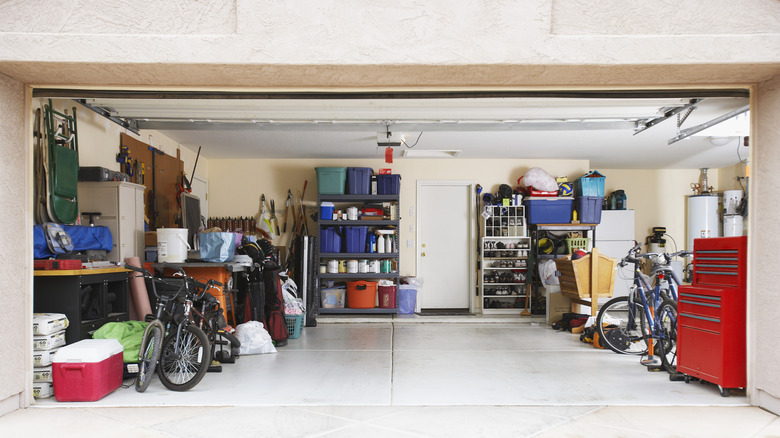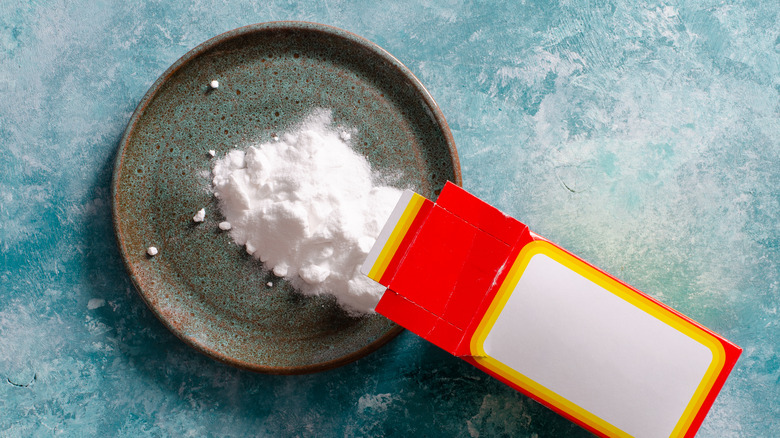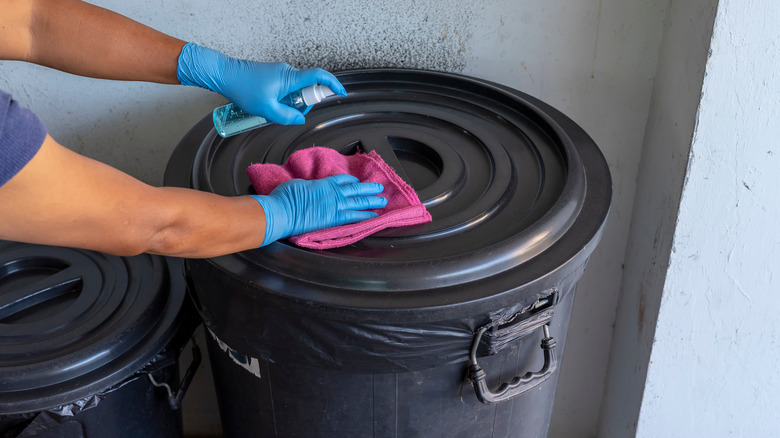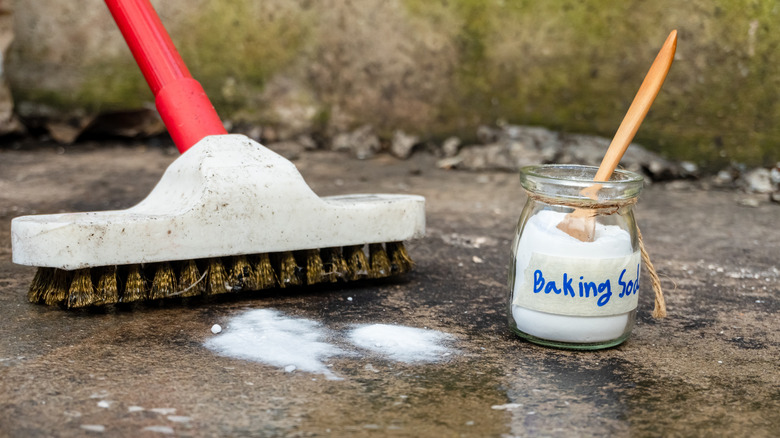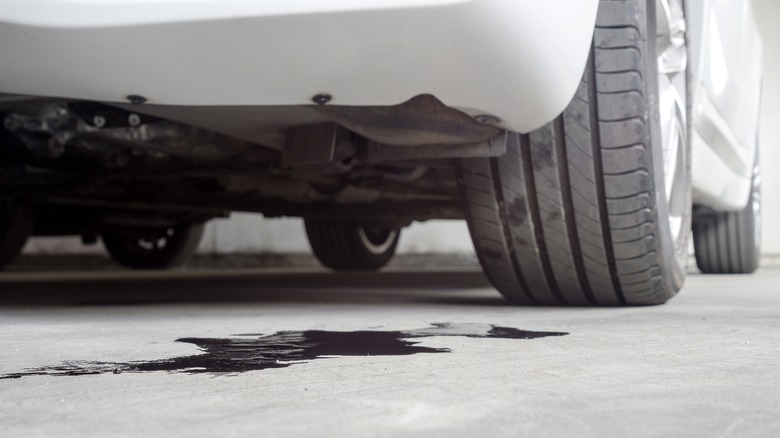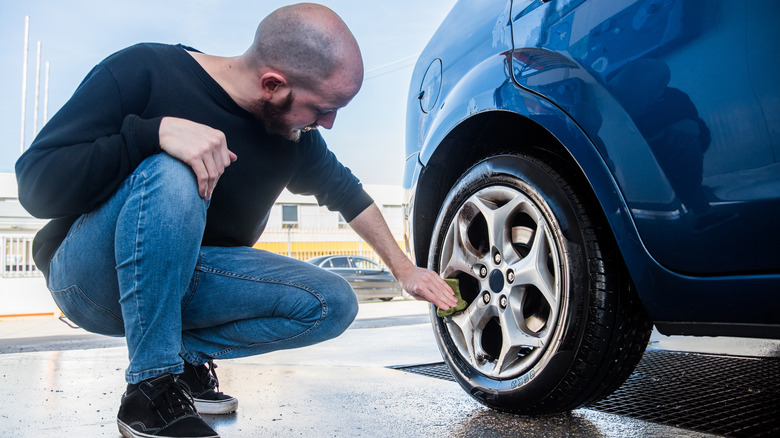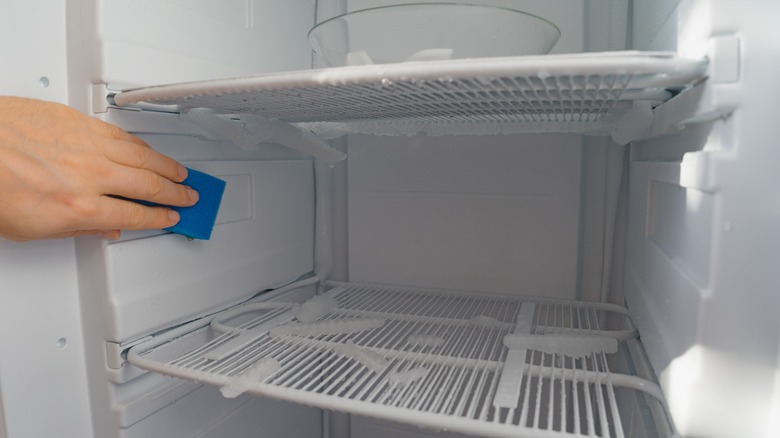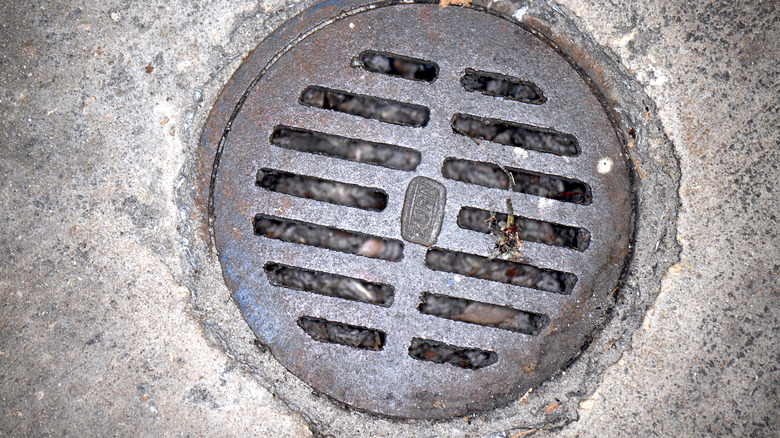Genius Baking Soda Hacks To Try In Your Garage
We may receive a commission on purchases made from links.
Baking soda is perhaps one of the most underrated pantry items. Aside from its inclusion in a variety of commercial products, such as toothpaste, air fresheners, and stain removers, it turns out there are even more unexpected ways you can use baking soda around your home. Some of these include tackling grime in your garage. Baking soda's versatility has to do with its key ingredient: sodium bicarbonate. Sodium bicarbonate has the capability of neutralizing acids that contribute to certain odors and stains.
The draw to baking soda is two-fold: it is a non-toxic, inexpensive, and accessible product, but it is also effective in cleaning and deodorizing a variety of areas. In your garage, this can include parts of your car, stored gear, flooring, oil spills, general odor removal, and more. While it's ultra-helpful to learn about all the ways you can use baking soda to keep your garage clean, it's equally important to know when you have a larger problem that might require professional care or commercial products. We break down the ways that baking soda can assist in the garage, as well as some situations where you might need to take more serious action.
Place multiple bowls (or boxes) of baking soda around your garage to combat odors
Placing an open container of baking soda on a refrigerator shelf is one of the most well-known ways to get rid of smelly odors in your fridge. It turns out this same hack may be applied to other spaces. As such, it may be worth trying it out in your garage to help get rid of any pernicious odors, as well as to prevent new ones. This odor-absorbing agent may even be strong enough to get rid of smoke smells related to wildfires.
You have two options for this hack. First, you can use the old trick of simply opening up new boxes of baking soda and strategically place them around your garage. You can put them on shelves, on the floor, on your workbench, and any other spot you can think of. A second, and perhaps more effective option, is to pour baking soda into bowls or plates and leave these situated around your garage for up to several days at a time. This method allows more baking soda to be exposed to the air, maximizing the surface area and giving it more chance to work against odors. Also, since baking soda is a neutralizing base, know that it may work best against more acidic odors, such as spoilt butter.
Don't feel like the hassle of pouring out baking soda into bowls, but you want maximum odor elimination? You can also try some of Arm & Hammer's Fridge-n-Freezer odor-absorbing boxes of baking soda. Amazon sells them at $12 for a pack of 12, and the brand claims that the box allows for airflow, while being spill-proof.
Clean odor-causing items in your garage with baking soda
Aside from opening up boxes of baking soda to eliminate odors in the air, you can also use this simple pantry staple as a cleaning or deodorizing agent to target common odor-causing items in your garage. You can potentially get rid of a variety of funky smells from your garage with baking soda, including those emanating from outdoor shoes, camping gear, garbage cans, or even items you might use at the lake or beach such as tubes and paddleboards. As a mild base cleaner, baking soda may also be considered a general cleaning agent to remove dirt and grease on any of these items.
Simply combine ½ cup of baking soda along with 3 tablespoons of water to create a DIY cleaning paste. You can adjust the thickness of the paste by adding or subtracting the amount of water until you achieve the desired consistency. If you keep garbage cans in your garage, consider regular cleanings with a combination of 1 gallon of warm water and 1 cup of baking soda. You can also lightly sprinkle baking soda on the bottom of your trash cans as a means of odor prevention.
Use baking soda as a concrete cleaner
While commercial concrete cleaners are always an option for cleaning the floors in your garage as well as your driveway, these may not be necessary if you have certain natural cleaning agents on hand. This includes baking soda. Baking soda is a mineral abrasive, along with salt and borax. Abrasive agents can clean a variety of surfaces, with coarser versions capable of cleaning concrete and certain outdoor grills made from stainless steel.
To use baking soda as a way to clean concrete floors, simply combine with warm water and apply to the concrete, gently scrubbing with a mop or soft-bristled broom. Keep in mind that this method is to be used in place of a power washer — never add baking soda to these types of machines. It's also important to note that baking soda may work best for unsealed concrete, and the abrasive nature might dull or scratch sealed, painted, or stained concrete. To be sure, you can always do a small test patch in an inconspicuous area.
Sprinkle baking soda on oil spills and stains
Baking soda may also be able to help clean up oil spills and stains on your driveway or inside your garage. First, the absorbent qualities of baking soda can help tackle fresh oil and gas spills. If, on the other hand, you don't catch an oil spill until it's stained your garage floor, baking soda may still come in handy. The mild abrasion that works to clean various items in your garage might help lift these types of stains.
To use baking soda for spills, try combining it with salt and placing this mix directly onto the spill. Allow the mixture to sit and naturally absorb the spill. Once it has dried, you can then sweep away any excess baking soda and salt with a broom. For dried oil that has already stained your garage floor, try sprinkling baking soda until you've created a thick layer, and then allow it to sit for 30 minutes. After this time, you may be able to scrub the stain away before rinsing with water. If this method doesn't work the first time around, you can safely repeat the process.
Also, be aware that baking soda isn't your only option for oil spills and stains. For example, cornstarch may be another pantry item you can use to absorb oil spills, while dish soap and cat litter can also purportedly help with removing stains. If baking soda or any other natural method fails, you may need to resort to commercial concrete cleaner.
Baking soda can help clean car wheels
There's a seemingly endless number of commercial car care products available at auto stores, but you also have numerous options for DIY car detailing. This includes kitchen items like baking soda. Due to its abrasive qualities, baking soda may also be a safe cleaning agent for certain types of car wheels and help remove stains and residue from oil, dirt, or grease. Additionally, baking soda can add shine to chrome.
For cleaning and shining chrome hubcaps, for example, you can create a paste made with baking soda and water and allow the product to air dry before buffing it off with a clean cloth. Aside from chrome, baking soda is also said to be safe for steel surfaces, which might make it an effective cleaner for wheels made of the same material. Alloy wheels may be cleaned with baking soda by combining ½ cup with 1 teaspoon of dish soap and a gallon of water. Take care not to use baking soda on powder-coated wheels, however, as the abrasion may damage them. Also, while dish soap and baking soda can help remove dirt and grease, you may need to use a commercial product if you're dealing with caked-on brake dust.
Clean your garage freezer with baking soda
If you have a freezer in your garage, you can use baking soda as a cleaner rather than an expensive commercial version. Just as with other areas of your garage, baking soda can act as an odor-fighter as well as a mild abrasive agent to supercharge your scrubbing.
To clean your freezer with baking soda, you will first need to defrost it. Once any ice buildup begins melting down, collect with paper towels and dispose of them. You can also wipe away any food particles that may have fallen onto your freezer surfaces. After all ice and debris have been removed, you can then start cleaning with baking soda. To use this hack, simply combine 1 tablespoon of baking soda with 1 quart of water, and then wipe down all surfaces again with clean water to make sure the paste is completely removed. You can place food items back in once the freezer has been turned on again and running for at least 30 minutes.
Unclog floor drains in your garage with a combination of baking soda and vinegar
A floor drain can be a valuable asset in your garage, allowing you to get rid of water runoff without the risk of accumulation. But just like any other type of drain, these too may sometimes get clogged. Before you reach for commercial drain cleaners though, you may be able to use a simple baking soda and vinegar recipe to help unclog your floor drain. These two ingredients have a reputation for being able to bust small clogs by creating a fizzy, carbon-dioxide-containing gas reaction.
To use this method in your garage, sprinkle ¼ cup of baking soda down the floor drain. Next, pour ½ cup of white vinegar. Allow the baking soda mixture to sit for at least 15 minutes, and then follow up with boiling or hot water. If the drain still works slowly, you may have to repeat the hack. However, continued issues may warrant other methods, such as creating a DIY drain snake. While baking soda and vinegar can work as an easy, natural fix for small drain issues, this is unlikely to help with big clogs, and these will probably require the help of a plumber.
